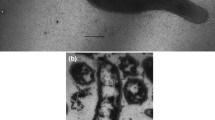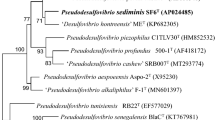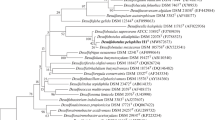Abstract
A new halotolerant Desulfovibrio, strain CVLT (T = type strain), was isolated from a solar saltern in California. The curved, gram-negative, nonsporeforming cells (0.3 × 1.0–1.3 μm) occurred singly, in pairs, or in chains, were motile by a single polar flagellum and tolerated up to 12.5% NaCl. Strain CVLT had a generation time of 60 min when grown in lactate-yeast extract medium under optimal conditions (37°C, pH 7.6, 2.5% NaCl). It used lactate, pyruvate, cysteine, or H2/CO2 + acetate as electron donors, and sulfate, sulfite, thiosulfate, or fumarate as electron acceptors. Elemental sulfur, nitrate, or oxygen were not used. Sulfite and thiosulfate were disproportionated to sulfate and sulfide. The G+C content of the DNA was 62 mol%. Phylogenetic analysis revealed that Desulfovibrio fructosovorans was the nearest relative. Strain CVLT is clearly different from other Desulfovibrio species, and is designated Desulfovibrio senezii sp. nov. (DSM 8436).
Similar content being viewed by others
Author information
Authors and Affiliations
Additional information
Received: 27 February 1998 / Accepted: 15 June 1998
Rights and permissions
About this article
Cite this article
Tsu, IH., Huang, CY., Garcia, JL. et al. Isolation and characterization of Desulfovibrio senezii sp. nov., a halotolerant sulfate reducer from a solar saltern and phylogenetic confirmation of Desulfovibrio fructosovorans as a new species. Arch Microbiol 170, 313–317 (1998). https://doi.org/10.1007/s002030050648
Issue Date:
DOI: https://doi.org/10.1007/s002030050648




